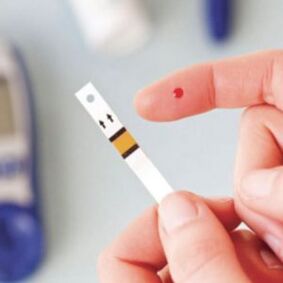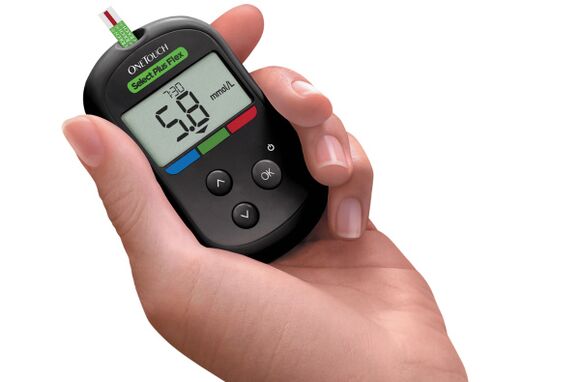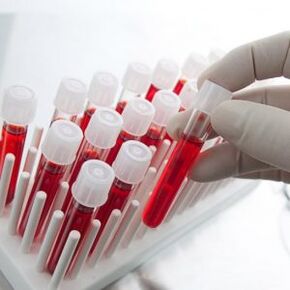
The symptoms of diabetes are a set of clinical manifestations specific to a particular disease, indicating doctors and patients on the occurrence or advancement of the pathological process.
Diabetes Mellitus is recognized as one of the most common diseases in the world, 350 million people across the world have suffered today. According to statistics, in just two decades, the number of cases increased by more than 10 times. About 90% of these people - diabetes of another type.
If you identify pathology in the initial phases, you can avoid a huge number of heavy complications. That is why it is so important to know which indicates the beginning of the disease and how a person needs to be examined to control this difficult endocrine pathology.
Diabetes manifestations do not depend on its kind. The human body can understand when enough energy ceases from glucose needed in this case, in the results of violations of its metabolism, and remains in abundance in the bloodstream, causing huge irreversible damage to systems and bodies. Metabolic processes are disturbed in the body provide lack of insulin, which is responsible for the glucose metabolism process. But the characteristics of the pathogenesis of the first and second type diabetes have significant differences, so it is necessary to know exactly the symptoms of each of them.
Main symptoms
Lack of insulin in the blood or reduction in the sensitivity of cells with insulin on the action of insulin in the body leads to a high blood glucose concentration. In addition to this symptom, which is considered a major diabetes, there are other signs that were discovered during the patient's medical observation. If the minimum suspicion of the presence of this disease appears, it is worth asking medical attention, because the early disease is susceptible to treatment, and in the modern world, even children in the school start suffering from diabetes.
The first manifestations

As the first manifestations of diabetes, doctors call numerous specific symptoms. In diabetes patients always have polyurism - fast and abundant urination, due to glycomy and the level of glucose in urine. It is a glucosure that is the cause that prevents fluid absorption by kidney structures. The polyuria is always followed by a thirst in which a person can consume up to 10 liters of liquid a day.
Despite the consumption of so much liquid, there is always a feeling of dry mouth. In case of diabetes of another type, along with thirst, a feeling of constant hunger appears. This is due to the fact that insulin produced pancreas in large quantities in the circle in the blood and is not used for their purpose, gives the signals to the brain about feeling hungry.
High level of glycemia causes serious damage to the body. Damage to nerve fibers leads to the occurrence of diabetic polyneuropathy. The first sign of such complication is the stiffness of fingers of the feet and arms and the appearance of strong pain in the limbs. If you start acting at the blood glucose level in a timely manner, the development of this process can be stopped and the syndrome of pain if you don't stop at all, it will be disturbing not so spoken. However, if you miss the beginning of the pathology advancement, you can wait for very difficult consequences - difficult pain, innervation, trophic ulcers and other things.
With the impairment of high glycemic vessel, diabetic angiopathy is developed. Clinically, at first, the disease is manifested by a sense of cloud clouds with a high blood glucose concentration, then a decline in vision sharpness follows, and even complete blindness in the absence of therapy. The appearance of any of the above symptoms, and even more, so their complex, should cause the patient to examine urgently to detain insulin insufficiency.
External events
Among the external signs, there are those who indicate the appearance of insulin resistance and high glycemism. For example, such a symptom can be a sharp development of dry skin, itching and scrub. It is especially important to pay attention to such skin events against the background of the simultaneous thirst. Also, with diabetes, itching often occurs on the mucosa of the genital mucosa, due to the irritating effect of glucose in the urine. There is no discharge at the same time, which is a characteristic characteristic of diabetes.
Also, sharp weight loss The signal is the beginning of the first type diabetes. In this case, it is necessary to observe some other symptoms of pathology so that they would not extract the abolition of arrested conclusions. Obesity and excessive body weight are not the symptom of the diabetes of another type, but can act as its cause. In any case, if a person's weight changes quickly in any direction without apparent reason, it is worth paying attention to and passing the doctor's exam.
Diabetes symptoms
First type

The first type diabetes is very fast in your development. He has his special events that should pay.
The patient has an increased appetite in his history, but he loses only weight, exhausted, suffers from sleepiness. Frequent instincts do not allow the toilet at night to sleep peacefully, forcing them to get up several times. The amount of urine in this case increases significantly, because the feeling of thirst is progressing.
Such symptoms cannot pass unnoticed, because it appears very sharp and suddenly. They follow him nausea, vomiting and strong irritability. It is especially important to pay attention to the permanent urge in the toilet at night in children, if not noticed before.
The main problem of the first type diabetes is the fact that glucose level can also increase in the blood and fall very sharp. Both countries are dangerous for health and have their own characteristics and events, which must be carefully monitored.
Another type
The most common is another type of diabetes. His events are very diverse, they appear gradually, so it is difficult to catch them immediately and recognize them. Mild symptoms usually do not lead to the fact that the person who discovered at home is beginning to sound an alarm immediately.
The second type of diabetes is characterized by the appearance of dry mouths, thirst, abundant urination, weight loss, fatigue, weaknesses and drowsiness. The feature of this diversity of diseases in the early stages is the presence of the thorn in the fingers and stiffness of the limbs, hypertennial events, the appearance of infectious processes in the urinary system. Similarly, the first type of patient diabetes can be disrupted by nausea and vomiting, dry and skin outer and skin infections.
It is important to remember that gradual development of symptoms leads to the development of the disease itself. Diabetes in later phases are full of hyperoslimolic cometar, lactoacidosis, ketoacidosis, hypoglycemia, which receive momentum in a few hours and can even lead to the patient's death. Also, as a result of advanced diabetes, patients often have serious vision problems, then lead to complete blindness, kidney or heart failure, pathology of vascular and nervous systems.
During pregnancy

Diabetes gestational sugar rarely manifests some specific external signs. It is most often learned by its presence with planned reviews that are regularly implemented on pregnant women. The main indicators are data from blood and urine tests.
In the presence of external signs of the disease, they are all very similar to the symptoms of the diabetes of the first two types, voments, weaknesses, weaknesses, weaknesses in the geniteal system, but on the second and third quarter of pregnancy in the evening of gestational diabetes.
The gestational form of pathology direct threats of the life of a mother or child does not carry, but may affect the general course of pregnancy, the benefits of future mother and fruit.
High blood content in glucose leads to a birth of a baby with a great weight (more than 4 kilos), which will be a prerequisite for his obesity or frequency of diabetes in any age. Delay in the development of a child, hypoglycemia, jaundice, on the first pores of life, newborns can be manifested.
Signs of complications
Diabetic foot
Diabetic foot in medicine is understood as a comprehensive anatomical and functional change in the tissues of distal parts of the lower extremities in patients with diabetes. This is the most important complication of the pathology considered, often lead to gangrene, amputation of limbs and disabilities.

If there is a history of diabetes in the health state of your leg, you need to follow very carefully. There are three main forms of diabetic feet: neuropathic (predominant nerve damage), ischemic (predominant lesion of blood vessels and blood flow disorder), mixed.
Among the complaints of patients preceding diabetics, experts differ uncomfortable feelings, ignition and sewing sensations in their legs, goosebumps, feeling of current discharge. If such symptoms disappear when walking, this indicates the beginning of the development of neuropathic form of diabetic foot. It is important to pay attention if the sensitivity occasionally disappears. If painful sensations arise directly when walking or at night (you can only convince the editor from the edge of the bed), then that means the beginning of the development of the ischemic form of diabetic foot called "Ischemite Foot".
Among the signs that indicate the beginning of diabetical foot, the skin differ on the skin on their feet or dry skin, peeling and dry skin, deformations between the fingers on their feet, spontaneous fringes of small bones to their feet. If a person notices at least a few such characters, you should urgently seek medical attention.
Retinopathy signs
Diabetic ophthalmology is manifested by changing blood vessels in the retina, leading to a breach of microcirculation in it. Such a violation leads to the occurrence of diabetic retinopathy. Such a complication is developed gradually and even in later stages, it can be almost invisible to the person.
The main signs of diabetic retinopathy are:
- the appearance of "fly" before the eyes;
- blurred vision;
- Vision sharpness reduction in later phases;
- Knorhage in a glassy body and retina.
In this case, diabetic ophthalmology can be manifested with two main forms - non-exteret (background) or a network network network retina. With background retinopathy, primarily the concern of pathology, only the retina itself. In the event of a violation in the capillary retina containers, the crowds, swelling of the retina and the deposition of metabolic products are returned. Retinopathy background is characteristic of older people with diabetes. It is conducted by a gradual reduction of vision sharpness.
Based on the background, proliferative retinopathy develops if the lack of support for support will increase. In this case, there is a pathological formation of new blood vessels that germinate from the retina into a glassy body. This process leads to bleeding in a glass body and sharp advancement vision vision in a person and irreversible blindness. In adolescence, such a transition of complications from a single form may occur in a few months, then the retina separation will follow and complete vision loss.
Signs of encephalopathy

Diabetic encephalopathy occurs as a complication of diabetes, due to diffuse degenerative brain damage. The prevalence of encephalopathy is directly dependent on the type of diabetes and its symptoms - to the duration of the disease flow and its weight. It belongs to late complications and manifests 10-15 years after the manifestation of diabetes.
The immediate cause of encephalopathy development is typical of diabetes, which leads to brain tissue damage and blood vessels. The upper processes lead to brain activity violations, reducing cognitive functions. The development of encephalopathy occurs very slowly, leading to difficulties in discovering its symptoms in the early stages.
The main symptoms of diabetic encephalopathy are:
- headaches and dizziness;
- Emotional instability, high fatigue, sleep disorders and other neurastinous disorders;
- the instability of the human walk;
- Bifurcation of the item when you look at them, fog visid, flickering "flies" before the eyes;
- mental, depressing disorders;
- Confused consciousness;
- Deterioration of mental activity, memory, concentration ability;
- moves, transient ischemic attacks, other pathologies of cerebral circulation;
- The occurrence of seizures.
At the initial phases, there is practically no complications of the clinic, and with the development of encephalopathy, the symptoms begin to appear clearer. Symptoms are identical with both types of diabetes.
The frequent satellite diabetes are atherosclerosis, arterial hypertence and obesity. In connection with the proud blood vessels in the case of atherosclerosis, the risk of ischemic moves and heart attacks. In the event of a microcirculation violation in renal vessels, the noise is an irreversible failure failure, which ultimately leads to a complete cessation of the kidney function. This, in turn leads to the need to replace therapy with renal failure by lifelong dialysis.
Diabetic coma
Diabetic cat means seriously reducing metabolic processes in the patient's body suffering from diabetes. The coma can also appear with a strong increase, and with a strong reduction in sugar in the blood of human blood.
This condition requires emergency medical care, because they are in her absence, a serious complication, and even death.

The coma is developing in phases, but quite fast. The first sign of the confluence in which it can be fiction, a rapid blood sugar, nausea and vomiting, drowsiness, abdominal pain per day or more before a direct coma. Another symptom of diabetic who can be desperate scent of acetone from the patient's mouth. Sensitivity can also occur in convulsions, thirst thirst.
With a hypoglycemic whom, blood sugar concentration decreases suddenly. The indicator can reach a mark of 2, 5 mmol per liter and below. Among the obvious symptoms of such a whom, unreasonable anxiety, fear of the patient, a sense of weakness, cramps, blood pressure and loss of consciousness stand out. Prekursors The appearance of hypoglycemic I can be:
- General Malase;
- lack of appetite;
- diarrhea or prison;
- Dizziness, headaches, tachycardia.
Lack of assistance in this country can lead to extremely serious consequences. Since the hypoglycemic coma is developing rapidly, the assistance provided should be urgent.
Sharply reduction in blood pressure in the patient, the weakening of the pulse, and softness of eyeballs may indicate a sharply reduction of blood pressure. Only a qualified doctor can lead a person to his senses in this state, so the urgent assistance call should follow as soon as possible.
Laboratory characters

You can reliably find out the patient diagnosis only after all the necessary laboratory tests. All laboratory tests for diabetes is focused on determining blood glucose indicators.
It is possible to accidentally identify blood sugar with mass exams a person before hospitalization or with an emergency determination of other indicators.
The most common is blood blood test, on an empty stomach. Before delivery, nothing can be eaten 8-12 hours. Also, you can't drink alcohol and you can't smoke an hour before donating blood. Level up to 5, 5 mmol per liter will be considered a normal indicator. If the indicator is equal to 7 mmol per liter, the patient will be sent to an additional review. For this purpose, they are tested for glucose tolerance. For this, the patient donates blood on an empty stomach, then drinks a glass of water with sugar (75 grams for adults for 200 milliliters of water), and 2 hours after that a peer blood test.
If the body is in normal state, then the first analysis will show the result of up to 5, 5 mmol per liter, and the other - up to 7, 8 mmol per liter. If indicators range, ie 5, 5-6, 7 and 7, 8-11, 1 mmol per liter, then to tell doctors about the development of pre-cycle in the patient. Indicators that cross these numbers indicate diabetes.
It is also common for the implementation of the Study on Glycolic Hemoglobin, showing the average value of human glucose in the last 3 months of life. The norm is an indicator below 5, 7%. If the value is between 5, 7-6, 4%, then it suggests that there is a risk of type 2 Melitus type diabetes. In this case, the measures with the doctor should be discussed to reduce such a risk. If the clacked hemoglobin is more than 6, 5%, it is probably diagnosis of diabetes, but requires confirmation. The recommended level of glycotic hemoglobin in people with diabetes is less than 7%, if this level is higher, it is necessary to discuss the situation with its present doctor. It should be borne in mind that the level of glitic hemoglobin is above 7% can evaluate the doctor as optimal.
Child symptoms
Diabetes can manifest at any age, including early children. Even are even diabetes of newborns. This is a rare case of the innate nature of the disease. The most common manifestation on children is made up for 6-12 years. Metabolic processes in children in this period continue much faster, and the state of a nervous system that is not shaped can affect the blood glucose level. The younger baby, it is more complex diabetes.
Among the main symptoms that parents need to pay attention to avoid missing the development of diabetes in children, doctors differ:
- thirst and dry mouth;
- nausea with vomiting;
- Frequent urine adhesion;
- Loss of weight and high appetite simultaneously;
- Fall of vision sharpness;
- High fatigue, weakness and irritability.
If the child has at least one of the above symptoms, it is the reason for the search for a doctor. If a few symptoms are detected, at the same time, the doctor should be immediate.
They can also occur among symptoms in children, typical and atypical signs of diabetes can appear. Doctors are attributed to typical symptoms that parents often confuse children - decorated with urine incontinence, polydypus, polyphagine, dryness of the skin after urinating, more than 5, 5 per liter per liter when blood is tested. Timely diagnosis in case of doubt will help identify the disease at an early stage and start the necessary therapy, which will not allow complications to be developed.
Determination of diabetes Melitus at home
The course of diabetes can be absolutely asymptomatic. It can be identified at random when visiting an optometrist or any other doctor. However, there are a lot of signs that can speculate in the presence of pathology independently. Moreover, you can make the type of disease quite accurately.
With a healthy body, after eating in the blood, the sugar level increases. After 2-3 hours after this, this indicator should be returned to its original limits. If this does not happen, then a person has a number of symptoms that cannot be noticed. This is already considered dry mouth, thirst, very frequent and abundant urination, increased appetite, apathy, cramps, mistakes. Gradually, the person begins to notice the skin of the skin, which has not been previously obvious.
Also at home, you can doubt the occurrence of diabetes in various strange sensations that a person has not previously noticed. In the second type of diabetes, this is a bad healing of wounds and scratches, the development of obesity. In the first type of pathology, the person, on the contrary, can lose weight sharply, although appetite is quite tall. Also, with all types of diseases, it is possible to show up the above size, increased hair growth on the face, forming Xanth (small yellow skin growth), hair loss in the limbs and others.
The timely identification of the signs of diabetes should be caused by a doctor.
Only if you start therapy for diabetes in the early stages, we can hope for a disease and normal quality of life in the future.
























